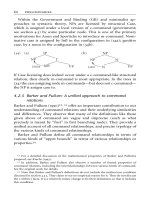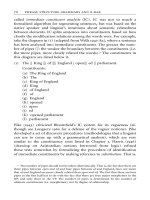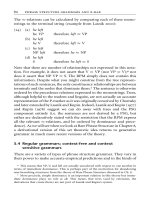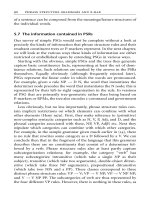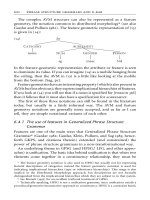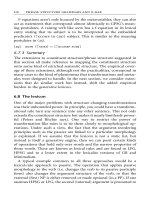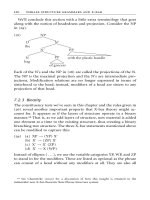Constituent Structure - Part 11
Bạn đang xem bản rút gọn của tài liệu. Xem và tải ngay bản đầy đủ của tài liệu tại đây (111.03 KB, 10 trang )
The %-relations can be calculated by comparing each of these mono-
strings to the terminal string (example from Lasnik 2000):
(24) (a) he left
he VP therefore left % VP
(b) he left
he V therefore left % V
(c) he left
NP left therefore he % NP
(d) he left
S therefore he left % S
Note that there are number of relationships not expressed in this nota-
tion. For example, it does not assert that V % VP (nor VP % V);6 nor
does it assert that NP VP % S. The RPM simply does not contain this
information. Despite what you might construe from the tree represen-
tations of such sentences, the onlyconstituency relationships are between
terminals and the nodes that dominate them.7 The sentence is otherwise
ordered by the precedence relations expressed in the monostrings. Trees,
although helpful to the student and linguist, are not actually an accurate
representation of the P-marker as it was originally conceived by Chomsky
and later extended by Lasnik and Kupin. Indeed, Lasnik and Kupin (1977)
and Kupin (1978) suggest we can do away with trees and the PSG
component entirely (i.e. the sentences are not derived by a PSG, but
rather are declaratively stated with the restriction that the RPM express
all the relevant %-relations, and be ordered by dominance and prece-
dence). As we will see when we look at Bare Phrase Structure in Chapter 8,
a derivational version of this set theoretic idea returns to generative
grammar in much more recent versions of the theory.
5.4 Regular grammars; context-free and context
sensitive grammars
There are a variety of types of phrase structure grammar. They vary in
their power to make accurate empirical predictions and in the kinds of
6 This means that VP, V, and left are actually unordered with respect to one another in
terms of immediate dominance. This is perhaps part of the motivation for abandoning
non-branching structures from the theory of Bare Phrase Structure discussed in Ch. 8.
7 More precisely, simple dominance is an important relation in this theory but imme-
diate dominance plays no role at all. This means that trees (and by extension, the
derivations that create them) are not part of Lasnik and Kupin’s system.
80 phrase structure grammars and x-bar
language systems they described. In this section, we look at a number
of diVerent kinds of PSG and what they can and cannot capture. See
Chomsky (1963) for a more rigorous characterization.
5.4.1 Regular grammars
First, note that the class of regular grammars and Wnite state automata
(discussed in Ch. 2, but not formalized) can, in fact, be captured with
a phrase structure grammar formalism. Recall that Wnite state autom-
ata start (usually) at the left edge of the sentence and work their way to
the right. It is relatively easy to capture this using a PSG. All we have to
do is ensure that the only structure that is expanded in each rule
application is the Wnal element (that is, they branch only rightwards;
there is never any branching on the left of a rule) or on the Wrst element
(that is, they only branch leftwards, there is never any branching on the
right side of the rule). Such grammars are slightly more restricted than
the kind we have above, in that on the left side of the arrow we may
have exactly one terminal and exactly one non-terminal (restricted to
one end). Take for example the Wnite state automaton in (25):
()
old
man
comes
the
men
come
•
•
•
•
•
•
This can be deWned by the following regular grammar.
(26) N ¼ {A,B,C,S},S ¼ {S}, T ¼ {the, old, man, comes, men, come},
P ¼ (i) S ! the A
(ii) A ! old A
(iii) A ! man B
(iv) A ! men C
(v) B ! comes
(vi) C ! come
This generates a tree such as (27).
phrase structure grammars 81
()S
the A
old
A
old
A
man B
comes
The problem with such a structure is, as we discussed in Chapter 2,
is that it does not accurately represent the constituency8 (which is,
of course [[the [old [old man]]][comes]], not [the [old [old [man
[comes]]]]]). Furthermore, there is no possible ambiguity in the struc-
tures, all the trees in this grammar branch strictly rightwards and
binarily. See Sag, Wasow, and Bender (2003) for careful discussion of
these problems. So, such grammars aren’t terribly useful in describing
human language. The fact that it is possible to represent a FSA using
the notation of PSG is not necessarily a bad thing, it just shows that we
need to explore in more detail how the powerful PSG notation can be
used and restricted. We can start this with one observation:
(28) The grammars of human languages are not regular grammars (i.e.
are not strictly limited to branching on one side or another.)9
The structures of human language clearly need more Xexibility than
this, but what kinds of limitations are there on PSGs? We deal with this
question in the next chapter.
8 See Langendoen (1975) for an attempt to force a regular grammar to produce correct
constituency. This is accomplished by not identifying constituency with the derivation, but
by having the regular grammar contain explicit rules for the insertion of constituency
brackets. These kinds of rules, however, miss the fundamental distinction between the
structures that the derivation is meant to represent, and the notational devices that are
used to mark the structures. By adding brackets to the inventory of elements that can be
inserted into the derivation, Langendoen blurs the line between the lexical items and their
constituency, and the devices that we use to notate that constituency; essentially equating
structural notions (right edge of constituent, left edge of constituent, etc.) with lexical
items. This kind of approach also (intentionally) disrupts the constituent construction
eVects of the actual derivation.
9 Interestingly, Kayne (1994) actually proposes that syntactic trees are universally
rightward branching, but he derives the surface order from a very abstract structure
using movement operations.
82 phrase structure grammars and x-bar
5.4.2 Context-free and context-sensitive phrase structure
grammars
Let us distinguish between two distinct types of PSG system. The Wrst
kind can make reference to other material in the derivation (known as the
context of the rule): context-sensitive phrase structure grammars (abbre-
viated either as CSG or CS-PSG). The rule in (29) is a typical example:
(29)BAC! BaDC
This rule says that the symbol A is replaced by a sequence of a terminal
a and non-terminal D, if and only if, it is preceded by a B and followed
by a C. That is, it would apply in context (30a), but not (30b) (or any
other context than (30a)):
(30) (a) ...BAC...
(b) . . . BAE . . .
There are two common formalizations of CS-PSGs. The format in (29)
is perhaps the most transparent. The format in (31) which expressed
the same rule as (29) is borrowed from generative phonology, and uses
the / and ___ notations, where / means ‘‘in the environment of ’’
and ___ marks the position of the element to be replaced relative to
the context:
(31)A! a D/B__C
This notation says A is to be replaced by [a D] precisely when A
appears in an environment where A is between B and C.
The second kind of phrase structure rule (PSR) is the context-free
phrase structure rule (the grammar containing such rules is abbrevi-
ated either CFG or CF-PSG). These rules disallow reference to any
context. Manaster-Ramer and Kac (1990) refer to such rules as uni-
sinistral (‘‘one on the left’’) as they only allow one symbol on the left
hand side of the rule (in the format in (29)).
(32)A! a D
The rule in (32) says that at any given step in the derivation (regardless
of context) A will be spelled out as . . . a D...
It has long been the assumption of practitioners of phrase structure
grammars that the syntax of human language is context-free (see e.g.
Gazdar 1982). In Chapter 2, we discussed some evidence from Zu
¨
ri-
tu
¨
u
¨
tsch and Dutch presented by Shieber (1985) and Huybregts (1984),
phrase structure grammars 83
which shows that syntax is at least mildly context sensitive (see the
original works for mathematical proofs). Interestingly, few researchers
have reached for CS-PSGs as the solution to this problem (however,
cf. Huck 1985 and Bunt 1996b); instead most have ‘‘extended’’ pure CF-
PSGs in some way. In the next chapter, we will explore many of these
extensions in detail.
5.5 The recursive nature of phrase structure grammars
Although not present in their earliest versions (Chomsky 1975, 1957)
most PSGs since the 1960s have included rules of a type that allows a
partial explanation of the fact that language is productive and allows at
least inWnitely10 many new sentences. Such rules (or rule sets) are
recursive. That is, you can always embed well-formed sequences in
other well-formed sequences using a set of phrase structure rules that
include recursive patterns. An abstract example of such a set of such
rules is given in (33):
(33) (a) A ! a B
(b) B ! b A
The application of each of these rules feeds the application of the other.
In other words, we have an inWnite loop. The application of rule (33a)
replaces an A with an a and the symbol B, whereas the rule (33b) can
10 I use the term ‘‘inWnitely’’ here in the imprecise sense as understood by lay people.
That is I (and most other authors) use the term to mean ‘‘not Wnite’’. This is a diVerent
from the mathematician’s view of what it is to be countably inWnite: you can apply a
function that puts each sentence in a one-to-one correspondence with a member of the set
of positive integers (a set which is by deWnition countably inWnite). The intuitive idea
behind the lay person’s meaning is that you have a productive system you can produce lots
and lots of sentences that have never been heard before, more so than have ever been
uttered and more so than we are likely ever to utter. So, more precisely, the claim is that the
syntax of languages are at least countably inWnite. Pullum and Scholz (2005: 15–17) argue
against the ‘‘inWnity’’ of human language, but their argument seems to be based on a very
narrow, and perhaps misleading, interpretation of the claim. They seem to have confused
the intended meaning of inWnite with the mathematical sense of countably inWnite.
Langendoen and Postal (1984) show that the set of grammatical sentences is greater than
countably inWnite. (From this, they conclude that generative grammars can not be correct,
but this is largely besides the point.) The point that most syntacticians are trying to make
about recursive systems is that they generate a set that is not Wnite. Whether the set
is countably inWnite and something larger is largely irrelevant to that speciWc point.
(Although in the long run it may bear on the larger question of whether generative rule
systems are plausible models of grammar or not—a question about which I will remain
agnostic.)
84 phrase structure grammars and x-bar



